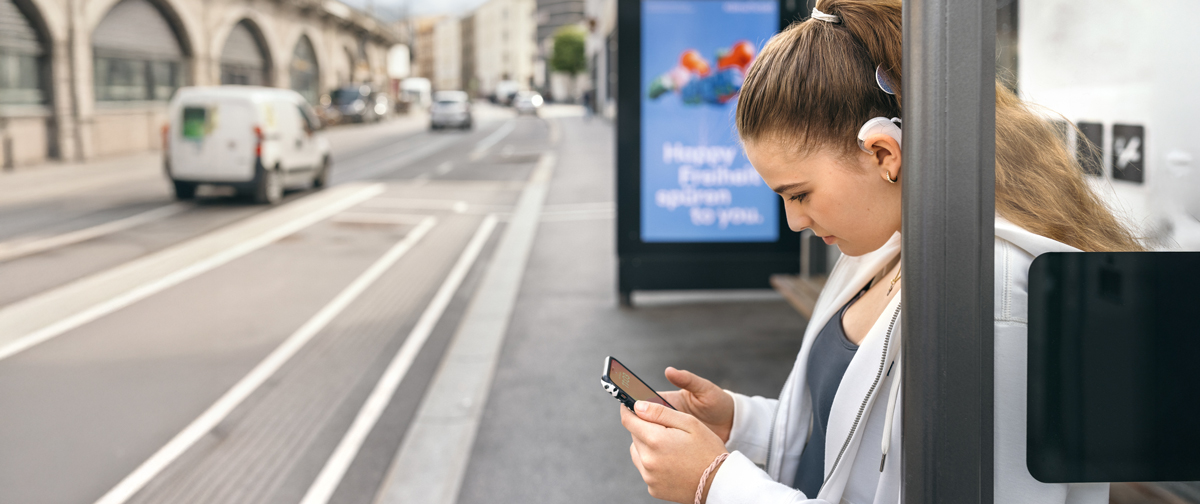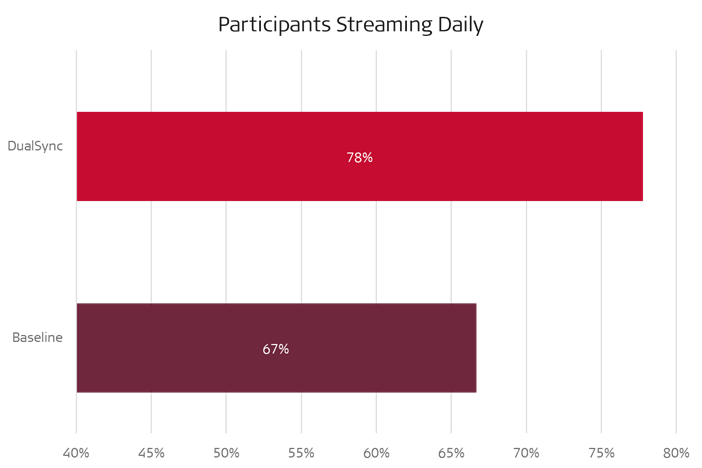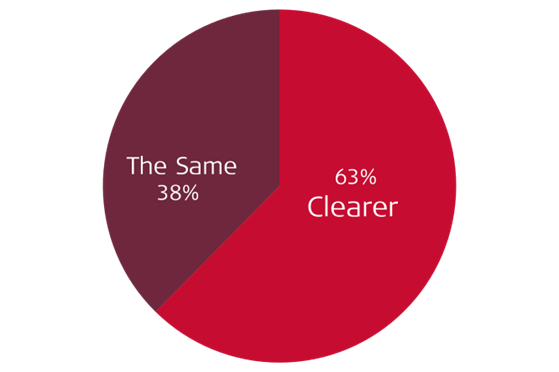Published Sep 25, 2025
Expanding Access to Seamless Bimodal Streaming with MED-EL and Starkey

MED-EL has long been a leader in cochlear implant innovation, committed to delivering hearing solutions that closely replicate natural hearing. In partnership with Starkey, a global leader in hearing aid technology, MED-EL introduces DualSync—a breakthrough in bimodal streaming that enables seamless audio delivery to both ears via Apple devices.
With DualSync, Apple devices recognize the MED-EL audio processor and compatible Starkey hearing aid as a unified system, allowing simultaneous streaming of phone calls, music, and media. This advancement builds on MED-EL’s existing Android compatibility and expands access to streamlined, cross-platform bimodal streaming for more users.
What are the Benefits of Listening with Two Ears?
Using a cochlear implant in one ear and a hearing aid in the other—known as bimodal hearing—can significantly enhance the listening experience. Benefits include:
- Improved speech understanding in quiet and noisy environmentsChing, T. Y., Incerti, P., & Hill, M. (2004). Binaural benefits for adults who use hearing aids and cochlear implants in opposite ears. Ear and Hearing, 25(1), 9–21. https://doi.org/10.1097/01.AUD.0000111261.84611.C8[1]Firszt, J. B., Reeder, R. M., Holden, L. K., Dwyer, N. Y., & Asymmetric Hearing Study Team. (2018). Results in adult cochlear implant recipients with varied asymmetric hearing: A prospective longitudinal study of speech recognition, localization, and participant report. Ear and Hearing, 39(5), 845–862. https://doi.org/10.1097/AUD.0000000000000548[2]
- Enhanced localization abilityChing, T. Y., Incerti, P., & Hill, M. (2004). Binaural benefits for adults who use hearing aids and cochlear implants in opposite ears. Ear and Hearing, 25(1), 9–21. https://doi.org/10.1097/01.AUD.0000111261.84611.C8[1]Firszt, J. B., Reeder, R. M., Holden, L. K., Dwyer, N. Y., & Asymmetric Hearing Study Team. (2018). Results in adult cochlear implant recipients with varied asymmetric hearing: A prospective longitudinal study of speech recognition, localization, and participant report. Ear and Hearing, 39(5), 845–862. https://doi.org/10.1097/AUD.0000000000000548[2]
- Better sound quality, clarity, and hearing satisfactionFirszt, J. B., Reeder, R. M., Holden, L. K., Dwyer, N. Y., & Asymmetric Hearing Study Team. (2018). Results in adult cochlear implant recipients with varied asymmetric hearing: A prospective longitudinal study of speech recognition, localization, and participant report. Ear and Hearing, 39(5), 845–862. https://doi.org/10.1097/AUD.0000000000000548[2]

MED-EL’s cochlear implant system provides a closer match in sound coding across ears for bimodal users by replicating natural loudness, timing, and frequency information:
- MED-EL’s 3:1 AGC compression ratio is the lowest in the market, designed to mimic the natural loudness growth of the basilar membrane, in order to more closely match natural hearing across a broad dynamic range.Vaerenberg, B., Govaerts, P. J., Stainsby, T., Nopp, P., Gault, A., & Gnansia, D. (2014). A uniform graphical representation of intensity coding in current-generation cochlear implant systems. Ear and Hearing, 35(5), 533–543. https://doi.org/10.1097/AUD.0000000000000039[3]
- The hearing aid delay feature within MAESTRO fitting software aligns cochlear implant and hearing aid processing delays, synchronizing processing speed across ears and providing benefits to speech recognition in noise and localization for bimodal users.Zirn, S., Angermeier, J., Arndt, S., Aschendorff, A., & Wesarg, T. (2019). Reducing the device delay mismatch can improve sound localization in bimodal cochlear implant/hearing-aid users. Trends in Hearing, 23, 1–13. https://doi.org/10.1177/2331216519843876[4]Richter, M. E., Rooth, M. A., & Dillon, M. T. (2024). Influence of matching the processing delays of cochlear implant and hearing aid devices for bimodal listeners on speech recognition in noise. American Journal of Audiology, 33(4), 1350–1355. https://doi.org/10.1044/2024_AJA-24-00026[5]Dillon, M. T., Buss, E., Richter, M. E., & Brown, K. D. (2025). Effects of interaural latency and frequency mismatch on speech recognition for bimodal cochlear implant users. Laryngoscope, 135(6), 2139–2145. https://doi.org/10.1002/lary.32026[6]
- OTOPLAN offers individualized electrode planning and objective postoperative data, which not only optimizes cochlear coverage, but reduces frequency mismatch to better complement the acoustic hearing of the contralateral ear, providing better speech understanding in complex listening environments.Dillon, M. T., Buss, E., Richter, M. E., & Brown, K. D. (2025). Effects of interaural latency and frequency mismatch on speech recognition for bimodal cochlear implant users. Laryngoscope, 135(6), 2139–2145. https://doi.org/10.1002/lary.32026[6]

Studying Early User Satisfaction with DualSync
In a study conducted at Idaho Ear Clinic in Meridian, ID, the world’s first patients to use DualSync provided early feedback on sound quality when bimodally streaming to their MED-EL audio processor and their Starkey Edge AI or Genesis AI hearing aid.
Both devices were configured for bimodal streaming in the AudioKey application. Participants were asked to stream with DualSync as they would in their normal daily routine, therefore not all participants used streaming in all situations. After a week-long trial with DualSync bimodal streaming, participants completed a survey regarding their streaming experience.
Demographics & Baseline Streaming Behaviors
The average age of study participants was 68 years at the time of baseline (range: 40-87). The majority of participants were new users with 75% having less than 6 months experience with their cochlear implant. Two participants were activated the same day they were configured for bimodal streaming.
Prior to the study, all but one participant were already streaming multiple times per day, using either direct streaming to their cochlear implant with SONNET 3 or via AudioStream, or streaming to their pre-operative hearing aids. At baseline, all but one participant indicated that having the ability to stream to both ears would contribute greatly to their overall listening experience.
Results: Streaming Bimodally with DualSync
After configuring devices for bimodal streaming in the AudioKey app, the proportion of participants engaging in daily Bluetooth streaming increased from 67% at baseline to 78% after one week of DualSync use.

Over half the participants reported noticeable improvements in clarity when streaming to both ears, with all participants reporting the sound quality with DualSync as being as good or better than their prior streaming setup.

Results of the 1-week user survey revealed improvements over their prior streaming setup:
-
100% reported improved sound quality with DualSync
-
80% reported increased enjoyment of music with DualSync
-
75% reported improved sound quality of phone calls with DualSync
-
75% reported improved ease of listening to phone calls with DualSync
Nearly half of participants reported that DualSync enhanced their satisfaction with their MED-EL cochlear implant and Starkey hearing aid, highlighting the meaningful contribution of bimodal streaming to patients’ overall hearing experience.
“I am very satisfied with my overall listening experience. The improved clarity is incredible. The sound is so crisp and clear you almost will have to turn the volume down. You will appreciate the ease and quality of DualSync immediately."
Participant
Industry Impact & Next Steps
“DualSync has not only opened the door for seamless bimodal streaming for MED-EL patients who use iPhone, but it is creating an opportunity for patients who were hesitant to begin streaming in the first place. Now these patients are bimodally streaming and loving it! This collaboration between MED-EL and Starkey is making a difference for bimodal patient outcomes.”
Dr. Michael Bateman, AuD, CCC-A
Clinical Audiologist, Idaho Ear Clinic)
Participants overwhelmingly enjoyed and preferred bimodal streaming, with reports of improved sound quality, ease of listening, and greater enjoyment from the bimodal Bluetooth streaming experience. DualSync enhances MED-EL’s commitment to individualized hearing solutions, joining tools like OTOPLAN and Anatomy-Based Fitting, to provide a closer to natural hearing experience for every patient. Continued work in bimodal hearing research will drive MED-EL innovations for an even more natural and individualized bimodal hearing experience.
To learn more about Bimodal hearing with MED-EL: Best Bimodal Hearing: MED-EL Cochlear Implants and Hearing Aids – MED-EL Professionals Blog
Interested in getting your patients set up with DualSync?
Learn how to set up bimodal hearing in MAESTRO so that your patietns can get the best out of their MED-EL devices.
Contact Us TodayReferences
-
[1]
Ching, T. Y., Incerti, P., & Hill, M. (2004). Binaural benefits for adults who use hearing aids and cochlear implants in opposite ears. Ear and Hearing, 25(1), 9–21. https://doi.org/10.1097/01.AUD.0000111261.84611.C8
-
[2]
Firszt, J. B., Reeder, R. M., Holden, L. K., Dwyer, N. Y., & Asymmetric Hearing Study Team. (2018). Results in adult cochlear implant recipients with varied asymmetric hearing: A prospective longitudinal study of speech recognition, localization, and participant report. Ear and Hearing, 39(5), 845–862. https://doi.org/10.1097/AUD.0000000000000548
-
[3]
Vaerenberg, B., Govaerts, P. J., Stainsby, T., Nopp, P., Gault, A., & Gnansia, D. (2014). A uniform graphical representation of intensity coding in current-generation cochlear implant systems. Ear and Hearing, 35(5), 533–543. https://doi.org/10.1097/AUD.0000000000000039
-
[4]
Zirn, S., Angermeier, J., Arndt, S., Aschendorff, A., & Wesarg, T. (2019). Reducing the device delay mismatch can improve sound localization in bimodal cochlear implant/hearing-aid users. Trends in Hearing, 23, 1–13. https://doi.org/10.1177/2331216519843876
-
[5]
Richter, M. E., Rooth, M. A., & Dillon, M. T. (2024). Influence of matching the processing delays of cochlear implant and hearing aid devices for bimodal listeners on speech recognition in noise. American Journal of Audiology, 33(4), 1350–1355. https://doi.org/10.1044/2024_AJA-24-00026
-
[6]
Dillon, M. T., Buss, E., Richter, M. E., & Brown, K. D. (2025). Effects of interaural latency and frequency mismatch on speech recognition for bimodal cochlear implant users. Laryngoscope, 135(6), 2139–2145. https://doi.org/10.1002/lary.32026
References
Was this article helpful?
Thanks for your feedback.
Sign up for newsletter below for more.
Thanks for your feedback.
Please leave your message below.
Thanks for your message. We will reply as soon as possible.
Send Us a Message
Field is required
John Doe
Field is required
name@mail.com
Field is required
What do you think?
© MED-EL Medical Electronics. All rights reserved. The content on this website is for general informational purposes only and should not be taken as medical advice. Contact your doctor or hearing specialist to learn what type of hearing solution suits your specific needs. Not all products, features, or indications are approved in all countries.




